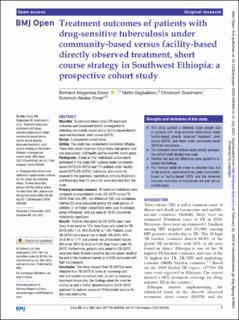Treatment outcomes of patients with drug-sensitive tuberculosis under community-based versus facility-based directly observed treatment, short course strategy in Southwest Ethiopia: a prospective cohort study
Peer reviewed, Journal article
Published version

View/
Date
2021-07-21Metadata
Show full item recordCollections
Abstract
Objective: To compare tuberculosis (TB) treatment outcomes and associated factors among patients attending community-based versus facility-based directly observed treatment, short course (DOTS).
Design: A prospective cohort study.
Setting: The study was conducted in Southwest Ethiopia. There were seven hospitals (five primary, one general and one specialised), 120 health centres and 494 health posts.
Participants: A total of 1161 individuals consented to participate in the study (387 patients under community-based DOTS (CB-DOTS) and 774 patients under facility-based DOTS (FB-DOTS)). Individuals who could not respond to the questions, mentally or critically ill patients, and those less than 15 years old, were excluded from the study.
Primary outcome measure: TB treatment outcomes were compared among patients under CB-DOTS versus FB-DOTS. Risk ratio (RR), risk difference (RD) and confidence interval (CI) were calculated among the study groups. In addition, χ2 or Fisher’s exact tests were used to compare group differences, with a p value of <0.05 considered statistically significant.
Results: Patients who opted for CB-DOTS were more likely to be cured by 12% than those who opted for FB-DOTS (RR=1.12, 95%CI=0.96 to 1.30). Patients under CB-DOTS had a lesser risk of death (RR=0.93, 95% CI=0.49 to 1.77) and a lower risk of treatment failure (RR=0.86, 95% CI=0.22 to 3.30) than those under FB-DOTS. Furthermore, patients who opted for CB-DOTS were less likely to have a positive sputum smear result at the end of the treatment period (p=0.042) compared with their counterparts.
Conclusion: The study showed that CB-DOTS is more effective than FB-DOTS in terms of improving cure rate and sputum conversion rate, as well as lowering treatment failure rate. Our findings show the need for scaling up and a further decentralisation of CB-DOTS approach to improve access to TB treatment service for the rural community.
Publisher
BMJ Publishing GroupSeries
BMJ Open;Volume 11, Issue 7Journal
BMJ OpenCopyright
© Author(s) (or their employer(s)) 2021
Except where otherwise noted, this item's license is described as Navngivelse-Ikkekommersiell 4.0 Internasjonal
Related items
Showing items related by title, author, creator and subject.
-
Fecal microbiota profiles in treatment-naive pediatric inflammatory bowel disease ? associations with disease phenotype, treatment, and outcome
Olbjørn, Christine; Småstuen, Milada Cvancarova; Thiis-Evensen, Espen; Nakstad, Britt; Vatn, Morten H; Jahnsen, Jørgen; Ricanek, Petr; Vatn, Simen Svendsen; Moen, Aina Elisabeth Fossum; Tannæs, Tone Møller; Lindstrøm, Jonas Christoffer; Söderholm, Johan D.; Halfvarson, Jonas; Gomollón, Fernando; Casén, Christina; Karlsson, Magdalena Kauczynska; Kalla, Rahul; Adams, Alex T.; Satsangi, Jack; Perminow, Gøri Margrete (Clinical and Experimental Gastroenterology;Volume 12, Journal article; Peer reviewed, 2019-12-13)Purpose: Imbalance in the microbiota, dysbiosis, has been identified in inflammatory bowel disease (IBD). We explored the fecal microbiota in pediatric patients with treatment-naïve IBD, non-IBD patients with gastrointestinal ... -
Opportunistic treatment of hepatitis C virus infection (OPPORTUNI-C): study protocol for a pragmatic stepped wedge cluster randomized trial of immediate versus outpatient treatment initiation among hospitalized people who inject drugs
Midgard, Håvard; Finbråten, Ane-Kristine; Malme, K.B.; Berg-Pedersen, Riikka Mari; Tanum, Lars Håkon Reiestad; Inge Christoffer, Olsen; Bjørnestad, Ronny; Dalgard, Olav (Trials;21, Article number: 524 (2020), Journal article; Peer reviewed, 2020-06-15)Background: Scaled-up direct-acting antiviral (DAA) treatment of hepatitis C virus (HCV) infection among people who inject drugs (PWID) is crucial to reach the World Health Organization HCV elimination targets within 2030. ... -
Survival and costs of colorectal cancer treatment and effects of changing treatment strategies: a model approach
Joranger, Pål; Nesbakken, Arild; Sorbye, Halfdan; Hoff, Geir; Oshaug, Arne; Aas, Eline (European Journal of Health Economics;, Journal article; Peer reviewed, 2019-11-09)New and emerging advances in colorectal cancer (CRC) treatment combined with limited healthcare resources highlight the need for detailed decision-analytic models to evaluate costs, survival and quality-adjusted life years. ...
